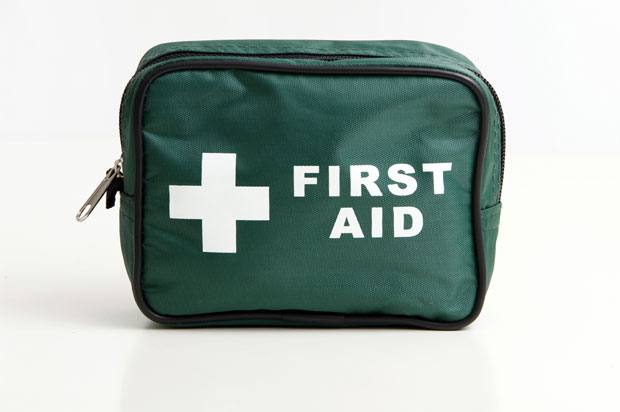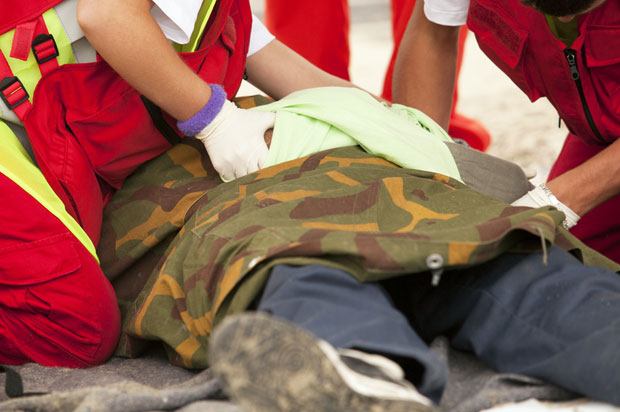General first aid
If you've injured yourself or someone's been in an accident, you might need to give first aid. Find out how to deal with the most common injuries and possibly save a life.

And this is how you put on a plaster...
Cuts
Most minor cuts and grazes can be taken care of at home, but more serious wounds should be treated at a hospital by a medical professional.
Treatment
- If the cut is bleeding heavily, remove any clothing surrounding the cut, raise the area, if possible, and apply pressure to the wound to reduce blood loss. If the bleeding is minimal, clean the wound with warm water and soap to get rid of any dirt.
- Look for embedded objects, such as broken glass, but don’t remove them as they could be preventing more severe blood loss. Leave them for a doctor (GP) or nurse to sort out.
- Put a non-fluffy sterile pad over the wound and apply pressure until the bleeding stops. If the bleeding soaks through the first pad, put another one on top. If the blood goes through both pads, replace them both with a new one and apply pressure to the wound.
- Raise the cut above the heart to help reduce blood loss.
- Keep the wound clean and change the dressing regularly to avoid infection.
- Don’t apply lotions, creams, ointments, adhesive dressings, or cotton wool to the wound as it can cause irritation and may lead to infection.
Seek medical attention
If the wound is particularly deep or the bleeding won’t stop, visit your nearest hospital immediately or call 999. If the wound begins to seep yellow or greenish pus, the skin around the wound becomes swollen or painful, or you have signs of a fever, it may have become infected and you should see your GP or go to A&E.
Burns
There are three depths of burn: superficial (redness), partial (blisters) and full thickness. Some partial burns and all full thickness burns will need medical attention, but if you are in extreme pain or have burns on your face, hands, feet or genital area, go to your nearest hospital or call 999.
Treatments
If you’ve burnt yourself:
- Poor cold water over the burn for at least 10 minutes to stop the burning and relieve pain. If possible, remove any clothing or jewellery around the burn whilst you’re cooling it.
- Once the burn has cooled down, cover it with a sterile non-fluffy dressing. Covering the burn loosely in cling film or a clear plastic bag will help prevent infection.
- Keep the dressing clean and change it regularly. Try not to burst any blisters as it can increase the risk of infection.
- As with cuts, don’t apply lotions, creams, ointments, adhesive dressings, or cotton wool to the burn, as this can irritate the skin.
Chemical burns
If you’ve received a chemical burn, gently pour cold water over it for at least 20 minutes and remove any clothing surrounding the burn if it hasn’t stuck. Cover it with a sterile dressing and seek medical attention immediately.
Fractures and dislocations
If you think you’ve fractured, broken or dislocated a bone, you should get it X-rayed. If you’re in severe pain or cannot move the affected area, call 999.
Treatments
If you have to move the injured area before seeking medical attention:
- Support the injured area with padding, bandages or a sling. To relieve any unnecessary movement, bandage the injured area to an unaffected part of the body, i.e. your arm to your shoulder.
- Make sure the bandage isn’t too tight so that blood can circulate freely around the injured area.
Allergic reactions
Allergic reactions can be triggered within seconds of coming into contact with an offending substance and can be extremely serious if not treated immediately. The symptoms of an allergic reaction are:
- Difficulty breathing
- Swelling
- Anxiety
- Blotchy skin or a rash
The majority of mild allergic reactions can be treated with antihistamines from a pharmacy. If you’ve suffered a severe allergic reaction (swelling of the face, throat or tongue) contact the emergency services on 999.
Shock
Physical shock is a major collapse of the body’s blood circulation. This can have a number of causes including: severe bleeding; severe vomiting and diarrhoea; massive infection; and poisoning. If it’s not treated it can lead to collapse, coma, and even death. The symptoms include:
- A fast but weak pulse
- Feeling faint, weak or sick
- Cold skin
- Pale face
- Blue lips
- Rapid, shallow breathing
Treatments
If you think you, or someone else, might be in shock:
- Call the emergency services immediately
- If it’s you who’s experiencing shock, you should leave your door unlocked so the paramedics can get in if you end up fainting
- Apply direct pressure to any bleeding wound
- Laying flat on the floor and raising legs at a 45 degree angle will help to restore blood pressure and reduce the chances of going unconscious
- Loosen any tight clothing and try and maintain warmth
- Food and drink should be avoided as this can cause vomiting
Thanks to St John Ambulance for help with this fact sheet. For more details of St John Ambulance first aid courses call 08700 104950.
Picture of a plaster being put on by Shutterstock.
Next Steps
- Chat about this subject on our Discussion Boards.
By Chris Denholm
Updated on 29-Sep-2015
Sorry, comments closed
No featured article








